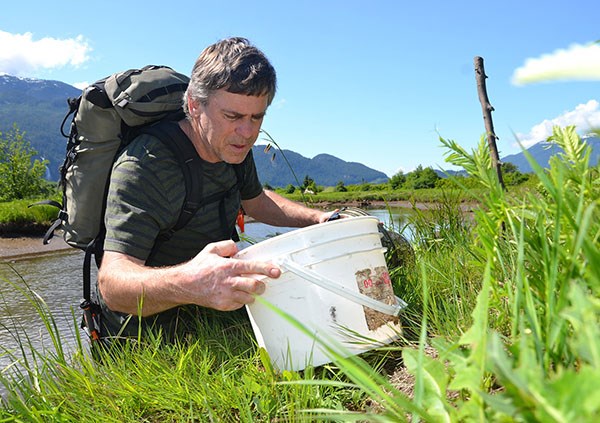John Buchanan pulls the trap out of the water.
He dumps the small, flapping fish into a white bucket.
“They’re all sticklebacks,” the long-time Squamish resident and environmental watchdog said. “That’s no good. A healthy habitat has diversity.”
For the past five years, Buchanan has monitored the Squamish Estuary east of the CN Rail tracks that lead to the Squamish Terminals. At least once a week for the past few months, he’ll record information such as water temperatures and what turns up in his fish traps.
Floodgates were added to Cattermole Creek, at the east end of the estuary along Third Avenue, in 1981. They were upgraded in 2010, Buchanan said. Buchanan started to notice differences in vegetation and wildlife in 2009.
“This has never been allowed to be covered with sea water for many years,” he said, gesturing to the area enclosed by the railway, dike and road to the terminal.
The floodgates automatically close when the sea level rises above 10 feet, he said, noting the ocean’s watermark on the gate can reach up to 16 feet. Cattermole Creek is artificially suppressed six feet below its potential. As a result, the sea water doesn’t venture far from the top of the banks, Buchanan said, noting there are no longer flood marshes in that part of the estuary.
“This is now an upland forest area. It is no longer estuary,” he said, pointing to the alder trees and grass normally found in pastures. “In a few years you will never see this area because it will all be forested.”
Across the rail track, the landscape changes. There are no alders and the thin, strand-like grass is replaced by the round, dark green stacks of sea grass. Small snails feast on the biofilm of last year’s decaying sedge grasses and Buchanan has documented ghost shrimp, sculpins and sticklebacks in the estuary’s pockets of ponds.
While the differences are visible, it wouldn’t take much to fix the problem east of the tracks, Buchanan said.
“Mother Nature won’t take long to revert back to what she wants,” he said.
On Tuesday (June 10), Buchanan is taking his concerns to the District of Squamish council. He’s going to ask that the floodgates allow more sea water into the area.
“There should be no difference on either side of the track,” Buchanan said.
District staff will provide a verbal report to council on the floodgate situation, municipal spokesperson Christina Moore said. The issue arose in July 2013. At the time, Mayor Rob Kirkham said staff hoped to meet with officials from the federal Department of Fisheries and Oceans (DFO) to examine the amount of water allowed in by the floodgates.
“Those gates have been operating the way they’re programmed to operate, but staff are arranging a meeting with [DFO] and looking to invite the local environmental groups to be part of the meeting and talk about the concerns and where to go with it,” Kirkham said at the time. “Our reaction is that if it’s a concern, then let’s get on it.”
— with files from David Burke



